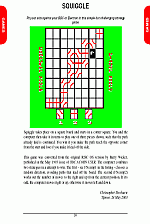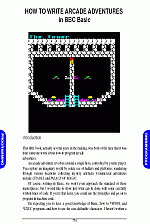In a little traversed corner of cyberspace lies former erstwhile contributor Chris Dewhurst's programming site. As has been noted in the Links section of Acorn Electron World for a number of months now, it contains some full scans of BBC and Electron programming books, and some extras for the game Weenies (which was published by Cronosoft in 2003). The programming works of Chris Dewhurst, with a range of informative articles by their side, are published regularly in EUGs #45 to #65. More utilities and games by him lie in the TBU archives of the 8BS web site. A great many of them share the polished presentation of his commerical release. In fact, Dewhurst practically seems a veritable, unstoppable, one-man Acorn series program-producing machine at times, churning out both variations on old themes (Father Christmas's Crackers, variant of Danger Uxb; Shields, variant of Xor; Lemons, variant of Lemming Syndrome, etc) and wholly new ones (Professor Blubble, Goldminer, County Quiz, etc).
Oh yes, there is little of the Beeb/Elk world that Dewhurst has not travelled. Machine code scrolling stars, music symphonies extraordinare through to whole new sets of star commands. Will you find any of this information on his web site though? No. Because instead Dewhurst has chosen to compile the last ten years of his BBC Micro and Electron programming into a book instead. Its name: The Complete BBC Micro Works Of Chris Dewhurst 1995-2005, weighing in at over 1,000 pages, and featuring 20 games, 16 utilities, 23 demos, 18 programming examples and 3 music editors. All of these are fully colour-coded and indexed. Now when was the last time something on that scale ever came along for a measley fiver before?!
The book is supplied on CD format with the textual files in Impression (Acorn RISC OS), PDF (PC) and html (Web pages) format. The Impression/PDF files are laid out very much in the style of the old Granada and PCN programming books, with the particular title followed by one screenshot, followed by a lead-in and description of what each program does - and finally the code. In the golden daze of the Eighties and Nineties, we would have to sit and type each line of this last bit in ourselves at the keyboard. Fortunately, working versions of all the programs are also supplied on the selfsame CD in a separate folder.
Some of the articles and demonstrations will, of course, be familiar to EUG readers and, unfortunately, the html pages of the CD are something of a disappointment when compared with the html versions on the EUG section of Acorn Electron World. They do not, for example, have tables, paragraphs, differing font styles/sizes or aligned screenshots. Instead any graphics that cannot be represented in textual form have been 'clipped' out of the PDF version and 'pasted' into the html one. Indeed, the html pages were originally my first port of call and - naturally for a web designer! - I believed that index.html would bring up the introductory pages. It does not. Instead it brings up the index of the book, and I spent my first half hour believing Dewhurst had practically ruined his masterwork with possibly the most unattractive boring textual 'front-end' interface I'd ever seen! When I viewed the PDFs I realised these were really the heart of what Dewhurst had been working on. The html pages are really something of a bonus to these.
Essentially, not only have you got the enjoyment of the games and blahdiblah, but you also have a in-depth analysis of what the various constituent parts that make them up actually do. In some of the very simple games, this is necessarily short, but in the more complicated ones, the "Technical Notes" can stretch into over ten pages. The style of writing is informative and no light is made of complicated programming concepts, although Dewhurst does sometimes adopt a more friendly style if he believes these may be starting to overwhelm the reader.
Personally I feel that it will be the demos and games that hold most interest and it will be the introductory pages, those giving the control keys and the plot scenario, that will be referenced most often. I suspect Dewhurst would not disagree that the explanatory notes are not to be read through from start to end in the same manner. The demos and games demonstrate the effects that can be achieved with clever programming and, one suspects, consulting the technical notes will be a job for those who wish to lift the elements that produce the effects for use in similarly styled games.
This is particularly so with the constituent elements, where the technical notes are, by necessity, much briefer than the considerably larger chapters accompanying the demonstration programs and utilities. As the games often result from Dewhurst intertwining routines he has developed to produce a desired effect on screen with a machine code game he has developed contemporaneously, almost all of the programs seem inextricably linked. The utility LineIt, for example, is featured in the game Plig; the demo for double-height sprites used in County Quiz.
Each section of the book is also presented in chronological order, hence further showing how Dewhurst built up his own programming knowledge. Despite that, I struggled to find anywhere where information had been needlessly duplicated.

Now the book is most definitely not for beginners to the BBC and Electron computers - it is practically 100% machine code programming with only a small number of BASIC listings. This means you should prepare yourself for some graphically astounding displays. I particularly liked the sixth BBC Demo which shows text folded in half through 90 degrees with a 3D perspective. With a few cosmetic changes, these are perfectly 'liftable' to your own programming efforts. As a prime example, the 'flood' effect in BBC Demo 5 (which you may have seen demonstrated on more 'able' computers before now!) would really give a professional-looking 'lift' to loading screens.
There are 80 disc images compatiable with PCBBC, BeebEm, ElectrEm and Elkulator which are all fully !BOOTable, and bring up their own 'Lutius' menu, including an option to view the text that describes the program on it as well as to run the program, or one of its constituent parts. All of the games have appeared elsewhere apart from Squiggle, which is an entertaining puzzle game that Dewhurst has converted from a listing for the Arc in BBC Acorn User magazine.

As with every disc these days, there seems to be an unwritten requirement that some 'extras' are included. Dewhurst has opted to include Roland Waddilove's intriguing series of Arcade Game Creator articles plus a few forgotten about Home Computer Course game listings. This just about fills up the whole of the CD and, as far as I can see, the only real drawback is that a number of typos and wrongly aligned paragraphs seem to have slipped the proof-reader's eye in some of the Impression and PDF documents. These do not really cause any problems though as the mistakes are fairly obvious.
Perhaps proving this book's quality beyond compare, one could practically write a review of almost each of every last program in its own right. Whilst some of the volume's features are bound to be familiar to some of you, its size really has to be seen to be fully appreciated. Under no circumstances would this reviewer want to print it out without half a box of paper, an extra print ribbon and two large lever arch files to hand. Yet practically every example not only demonstrates its subject in an attractive manner but also teaches how every byte of the code is being used in the most memory-sparing way possible. The slick programming, and the comparatively simple prose that illuminates it, ultimately destines this book as The Bible for a budding BBC gamemaker.